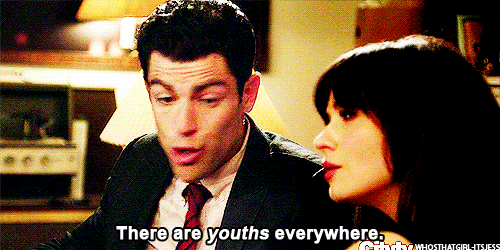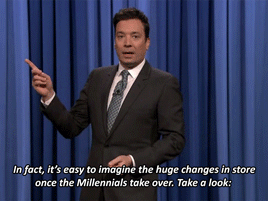Hi. I’m Anastasia Dextra. Ana for short.
I’m a twenty-something, left-leaning, feminist, woman of color employed at a digital marketing agency with a B Corp designation. I hold degrees in Media & Cinema Studies and Environmental Studies from an urban liberal arts university. And in my free time, I’m a champion of equal representation in media and the academy. It should also be noted that I enjoy the occasional concert and Thai fusion burrito.
Okay, so before I continue; let’s address the obvious. My hunch is you’re probably thinking a few, if not all, of these things right now:
- This is way too much unnecessary information.
- I came to read about digital marketing, not a memoir on the life and times of Ana Dextra.
- Why does this matter?
- What should I have for lunch?
First off, order the hummus. ALWAYS ORDER THE HUMMUS. You can never go wrong with Mediterranean food. Secondly, don’t worry, I haven’t added mind reader to my list of qualifications–yet.
So, what’s with all the exposition? I’m sharing my life’s path because statistically speaking, I should be a sucker for socially responsible companies. And don’t get me wrong, I am–when they are marketed in the right way. You see, I’m a millennial.
I’ve seen it time and time again. Companies, brands, and even charitable organizations have made claims of sustainability and equity. They’ve done so in (all!) of their marketing materials and then waited. And waited. And waited in vain for hordes of consumers to shop their products, donate their money and dedicate their time because of their charitable cause. And you know what? The crowds never show.

Millennials, like me and my 75.3 million peers, make up the majority of the nation’s population. Moreover, we’re a giving bunch with a lot of buying power. Outside of being called the “Me, Me, Me Generation” (I’m looking at you Time), millennials have also been lauded for their passion and social activism.
Do you remember those hordes I mentioned earlier? The ones that went missing in action? I’m here to show you why some socially conscious companies are failing to attract their attention and offer solutions on how your business can avoid the same pitfalls.
What Matters Most to Millennials
Since 2009, The Case Foundation has released their annual Millennial Impact Report. The report exists largely due to the fact that millennials are defining and shaping culture as we know it. Over the course of the last five years, researchers have seen the following trends emerge. These trends indicate what matters most to Generation Y when it comes to cause based organizations and will supply the context needed for my millennial marketing assessment:

- Millennials engage with causes to help other people, not institutions.
- Millennials support issues rather than organizations.
- Millennials prefer to perform smaller actions before fully committing to a cause.
- Millennials are influenced by the decisions and behaviors of their peers.
- Millennials need to experience an organization’s work without having to be on site.
Saying You’re Socially Conscious is Not Enough.
Everything we do in life is motivated by some deeper desire or mission. There’s a larger why that informs our actions. Many social justice focused organizations miss the mark when it comes to talking about their why. They tend to lead with the fact that they’re socially conscious and don’t tend to follow up with much else. This a mistake–a big one.
It’s good for consumers to know that you care about affecting positive change in the world, but as supporters of ideas and issues, a millennial audience needs to know what you stand for (and why) before deciding to stand with you. Taking the larger step of crafting and communicating your business’ origin story in a way that connects to the larger why behind your mission shows a strong dedication to causes that mean a great deal to your company. And as a result, companies will see a larger investment from socially active and engaged millennials.
Don’t Just Tell. Show.
It’s cliché; but the trite often rings true: a picture is worth a thousand words. And video? Well, when done right, that can increase your word count exponentially! Don’t just talk about your philanthropic efforts, show them in action. Remember: young people are more likely to support causes that help others. In one survey, over 60% of millennial respondents said they liked when nonprofits shared stories about successful projects or the people they help. Let them see that you do.
Add vibrancy to your communications by highlighting seasoned volunteers in a video interview or by snapping a pic of the coastline clean-up made possible by purchasing your product. Sprucing up your feed with videos and pictures of your community and its efforts is a surefire way to increase engagement and expand the reach of your organization through likes and shares.
Contribute to the Conversation.

I can’t tell you how many times I’ve seen organizations miss opportunities to reach engaged audiences simply because they were too sheepish to speak up. You can’t be neutral; especially when you’re operating as a socially responsible business. That’s precisely why your customers chose your product; because you took a stance on a topic that means a great deal to them. Don’t shy away from the issues your company and community rallies behind online. Nearly 7 in 10 Gen Y-ers (69%) surveyed don’t like seeing the same messages or being asked to donate time/funds via social media over and over again. Take this as a sign to diversify your content by posting original articles or opinion pieces that address your value system. It is important to keep in mind that millennials support issues more so than organizations. Speak up and show that you support them too.
Lead the Way
Many nonprofits make calls to actions that lead to few, if any, answers. The reason for this is pretty simple. They can’t find out how to help! It’s very hard for people to follow you down the road to social justice when you haven’t left a clear path or contact information. Over 50% of millennials indicated that they’re annoyed when they’re unable to find nonprofit details, like contact information, quickly and easily. These figures are especially startling when supplemented with the fact that nearly half of respondents follow 1-5 organizations on social media, with ¾ of them liking, retweeting and sharing social content. The failure of an unoptimized website can often lead to staggering drops in the rates of potential engagement. Think of all the people not sharing your content with their friends! And as we know, people are heavily influenced by the decisions and behaviors of their peers.
That’s why at Lightspan Digital, one of our first courses of action is to conduct a general audit of every website we touch. This ensures that no opportunities to engage customers are ever forfeited.
Show Your Humanity
39% of Millennial Impact Report respondents said they prefer it when organizations interact with them informally on social networks, rather than try to connect with them using formal PR pitches. It’s a new age, and old PR tactics don’t resonate well with a millennial audience. The keyword in the term “social media” is “social”. When online, people want to feel like they’re connecting with other human beings. The feelings of connection that a genuine interaction can illicit can be transformative when it comes to connecting people with your products and/or services. At the end of the day, people are drawn to social justice focused businesses because of their dedication to making the planet better for all human beings. So when engaging online, don’t forget to be one.
Are you a socially conscious organization? Are you ready to dedicate your time to attracting the right tribe to help you change the world? We think that’s pretty cool, admirable even! Contact us to find out how we can help you translate social responsibility into social engagement!

Leave a Reply